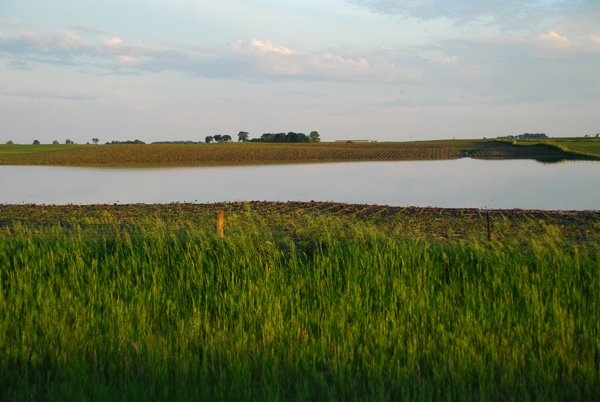July 2, 2013

The June weather pattern in Illinois was variable, and the month is ending with rainfall totals ranging from a little less than normal in parts of western Illinois to nearly double the normal amounts, with some totals as high as 7-8 in., in parts of southeastern and northern Illinois.
While getting rainfall in June is certainly preferable to getting little or none as happened in Illinois in 2012, standing water and wet soils can badly damage a rapidly growing corn crop. In June 2010, 2-4 in. of rain fell during the fourth week of June over most of central and northern Illinois. With the crop planted early and developing rapidly under high temperatures, standing water resulted in serious and irreparable damage to root systems. This lowered yields in low-lying fields and parts of fields, even where rains fell later in the season.
When soils remain saturated for more than a day or two, the lack of oxygen causes nutrient uptake to slow quickly, and root tips start to die off. It helps that temperatures have not been above normal; cooler water carries more dissolved oxygen, and also slows growth and nutrient uptake. Also, plants during vegetative growth have much better ability to grow back damaged root systems once soils drain than do plants during or after pollination.
Like what you're reading? Subscribe to CSD Extra and get the latest news right to your inbox!
These factors, along with the very good crop color (which indicates good root activity and adequate supplies of soil N) before the rains in late June, point to good chances for recovery of crop yield potential in fields and parts of fields where the water is no longer standing. In the short run, plants may lose some of their green color before roots are fully functional again, but this will likely be a temporary condition. While many worry that any stress during mid-vegetative growth will lower yield potential, there’s not much evidence that a few days with reduced photosynthetic rates has much effect on yields, at least if this occurs more than a week before tasseling.
Flooded Soils and Nitrogen Needs
Regardless of how quickly the crop returns to normal after an event like temporary flooding, questions will remain about how standing water might affect the amount of nitrogen left in the soil to meet the needs of the crop. Warm, saturated soils lose nitrogen (as gas back into the air) through the process of denitrification. We do not think that such losses have been very large in most fields, given the temperatures and the fact that most flooding was temporary. In better-drained fields, denitrification would be less, but percolating water has probably moved some of the nitrate-nitrogen deeper, perhaps below the root system or into tiles lines.
In central Illinois we have accumulated about 1,100 growing degree days (GDDs) since May 1, and about 930 GDDs since May 15. By the time corn accumulates 1,000 GDD, reaching about stage V13, it has accumulated about 20% of its dry weight and about 40% its season-long nitrogen accumulation (Abendroth et al., 2011) During this period the crop takes up 3-3.5 lbs. of nitrogen per acre per day, and by the time of pollination, it will have taken up about 60% of its nitrogen and produced about 40% of its dry weight.
At the time the crop reaches stage V13 (about head-high), it still has to take up 110 to 120 lbs. of nitrogen, and in years when June is wet, a common question is whether or not the crop might run out of nitrogen, leaving the crop short. While the need for 20 or more lb of N per week would seem to raise the possibility of a shortage, the production of plant-available N from soil organic matter through the process of mineralization is also at its maximum rate in mid-season.
For a crop with a good root system growing in a soil with 3% organic matter, mineralization at mid-season likely provides at least half the nitrogen needed by the crop on a daily basis. This means that normal amounts of fertilizer nitrogen, even if there has been some loss, should be adequate to supply the crop.
Though we could measure soil nitrogen present or apply urea by air on the wetter field or parts of fields where the crop shows deficiency, it would seem prudent to wait to see if the crop recovers its green color before going to this expense. The loss of crop color in wet soils is due mostly to loss of root function, and roots will need to recover before the canopy does. Even without adding more N, odds are good that the crop will recover and thrive in the coming weeks, providing the weather remains favorable.
Read the article at The Bulletin website.
You might also like:
Apply for the 2014 Conservation Legacy Awards
You May Also Like




